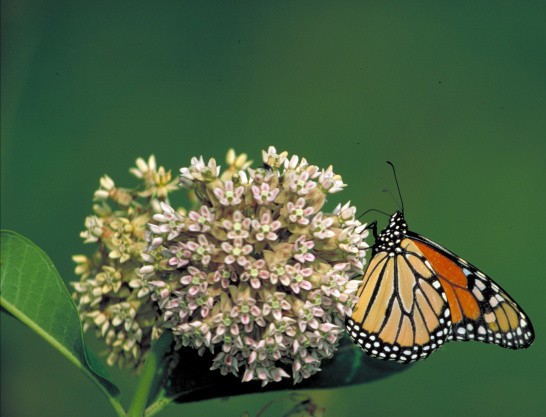Summer is a magical time for watching butterflies. A quick hike in the woods, a few quiet moments in a garden, or even a walk down a city block almost always turns up a few butterflies, more if you’re looking for them. Amidst this bounty of butterflies, here are five species likely to be flying whenever you venture outside:
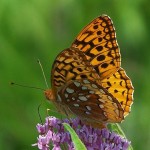 With its bright orange color, black markings above, and silver spots below, the Great Spangled Fritillary is easy to recognize and, unlike most butterflies, will sit still on a flower head. Fritillaries are the reason I let wild violets grow in my lawn and garden—in the spring, young caterpillars who have overwintered in the leaf litter, crawl to a nearby violet patch and begin munching.
With its bright orange color, black markings above, and silver spots below, the Great Spangled Fritillary is easy to recognize and, unlike most butterflies, will sit still on a flower head. Fritillaries are the reason I let wild violets grow in my lawn and garden—in the spring, young caterpillars who have overwintered in the leaf litter, crawl to a nearby violet patch and begin munching.
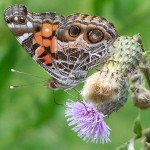 This must be the year of the American Lady butterfly; they’re everywhere! This lovely, medium-sized butterfly lays its eggs on Pearly Everlasting and pussytoes. When resting with its wings upright, it displays a splash of pink on its forewing and two large blue-centered eyespots on its hindwing (in contrast to the Painted Lady, which has four smaller spots on its hindwing).
This must be the year of the American Lady butterfly; they’re everywhere! This lovely, medium-sized butterfly lays its eggs on Pearly Everlasting and pussytoes. When resting with its wings upright, it displays a splash of pink on its forewing and two large blue-centered eyespots on its hindwing (in contrast to the Painted Lady, which has four smaller spots on its hindwing).
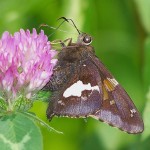 Skipper butterflies are like the LBJs (little brown jobs) of the bird world and can be maddeningly difficult to identify. That being said, of all the Skippers, one is easier to ID than the others: the large Silver-spotted Skipper. A wonderful introduction to the world of skippers, the silver spot on its hindwing flashes like a beacon as it nectars in gardens, meadows, and roadsides.
Skipper butterflies are like the LBJs (little brown jobs) of the bird world and can be maddeningly difficult to identify. That being said, of all the Skippers, one is easier to ID than the others: the large Silver-spotted Skipper. A wonderful introduction to the world of skippers, the silver spot on its hindwing flashes like a beacon as it nectars in gardens, meadows, and roadsides.
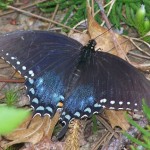 If you’re in a sun-dappled woodland and a large, black butterfly with iridescent blue clouding on the top of its hindwings flies by, it’s probably a Spicebush Swallowtail. Its distinctive caterpillars, with large fake “eyespots,” feed on spicebush and sassafrass. One of my happiest springtime memories is gently uncurling young sassafrass leaves to greet the new caterpillars.
If you’re in a sun-dappled woodland and a large, black butterfly with iridescent blue clouding on the top of its hindwings flies by, it’s probably a Spicebush Swallowtail. Its distinctive caterpillars, with large fake “eyespots,” feed on spicebush and sassafrass. One of my happiest springtime memories is gently uncurling young sassafrass leaves to greet the new caterpillars.
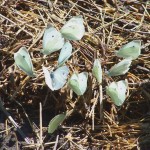 The Cabbage White may be an odd choice for this list. It’s a non-native butterfly, which feeds on invasive garlic mustard plant and the crucifers of our vegetable garden. But given a little time, the Cabbage White, which is often mistaken for a moth, can work its way into a butterfly lover’s heart. I can always count on it to make an appearance, even when no other butterflies are flying.
The Cabbage White may be an odd choice for this list. It’s a non-native butterfly, which feeds on invasive garlic mustard plant and the crucifers of our vegetable garden. But given a little time, the Cabbage White, which is often mistaken for a moth, can work its way into a butterfly lover’s heart. I can always count on it to make an appearance, even when no other butterflies are flying.
Want to learn more about butterflies and how to attract them?
- Take a butterfly program at a nearby Mass Audubon wildlife sanctuary.
- Come to the Barbara J. Walker Butterfly Festival at Broad Meadow Brook Wildlife Sanctuary in Worcester in August.
- Connect with the Massachusetts Butterfly Club.
- Read in-depth species accounts in our Butterfly Atlas.
- Watch the This Old House segment on Butterfly Gardens filmed at Broad Meadow Brook.
Photos via Frank Model


